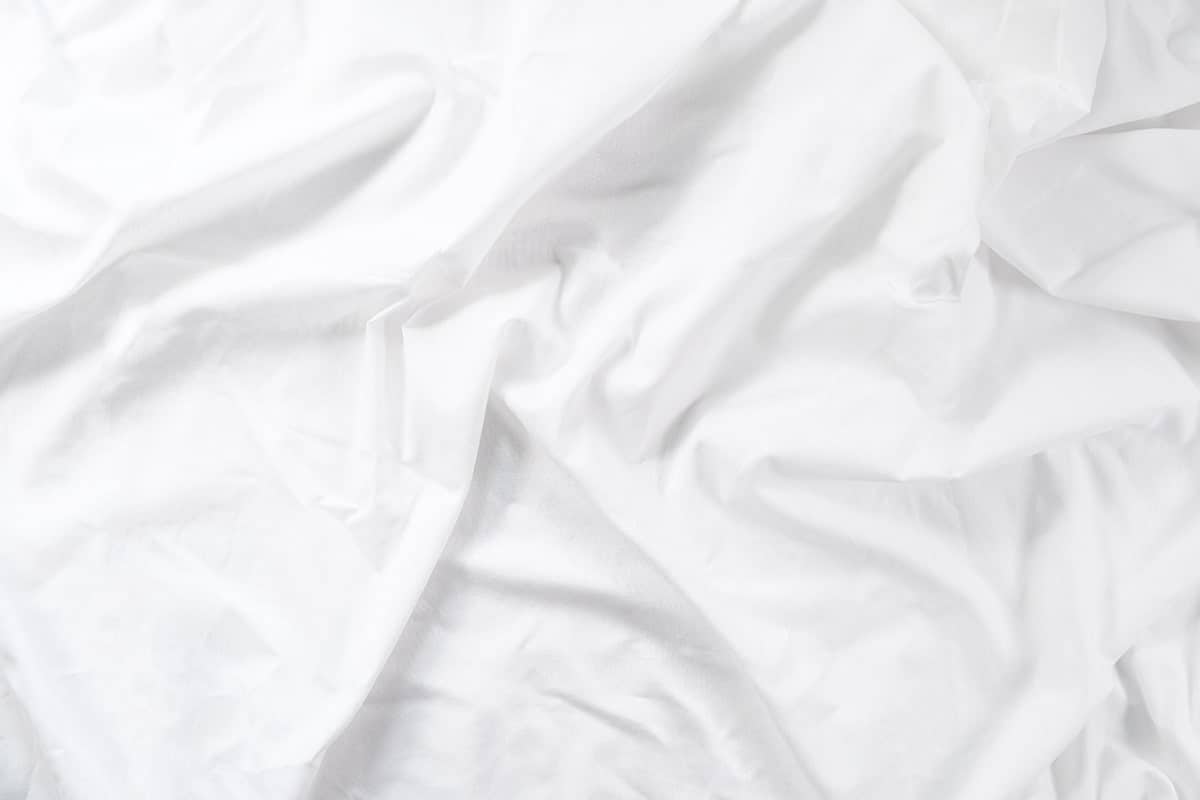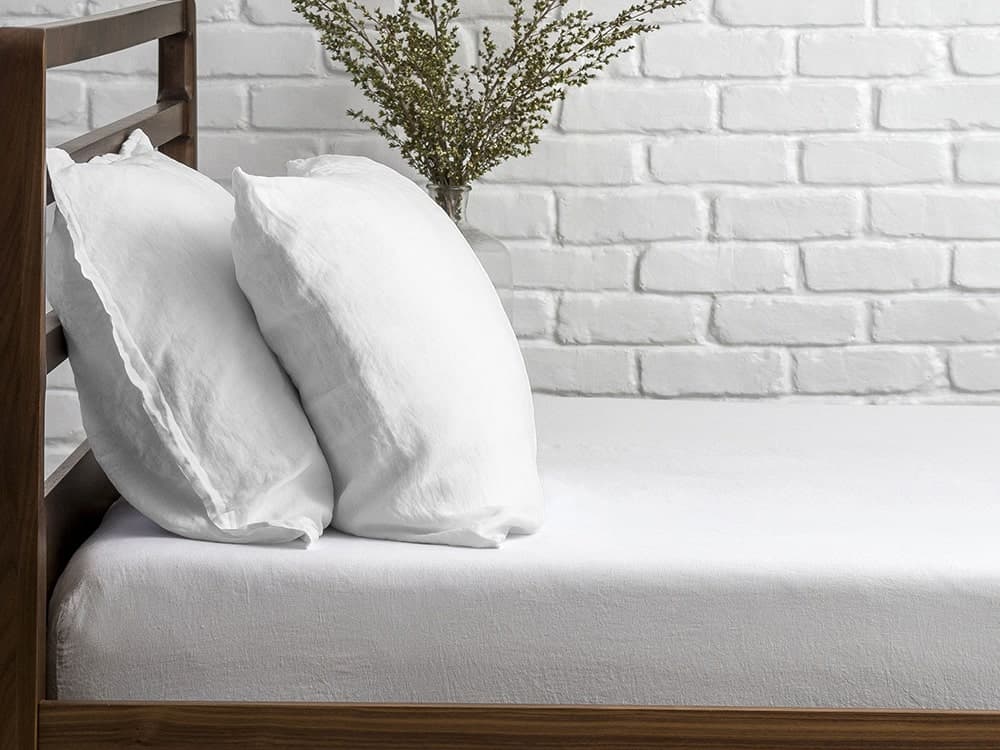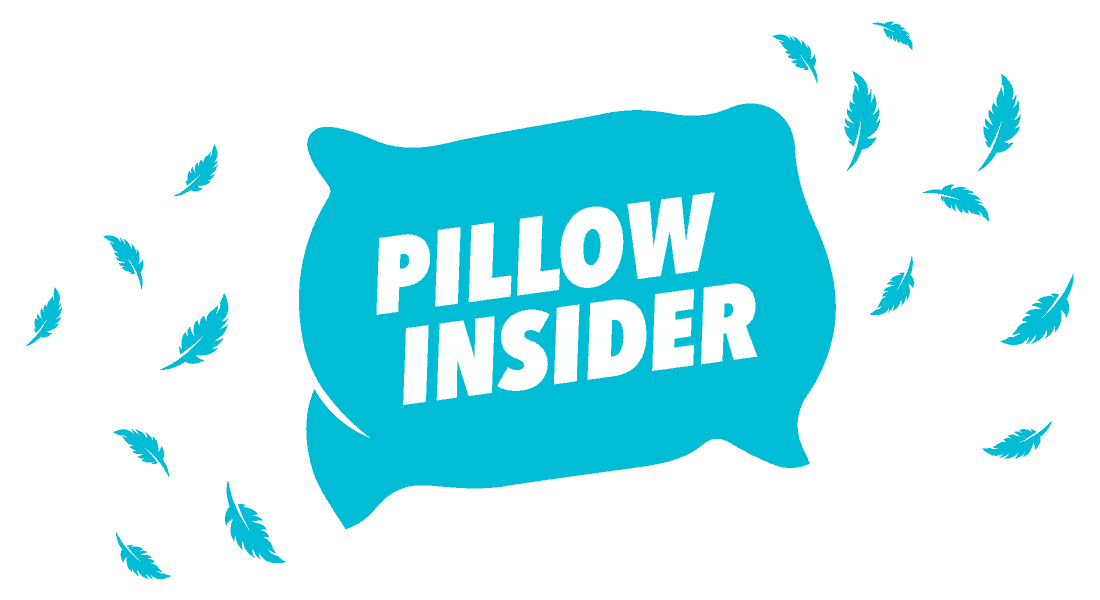Choosing the right material for bed sheets is just as important as determining its weave pattern. After all, an exhausting day at work should only end with a relaxing and comfortable sleep at night, which is practically impossible without the right bed sheets type.
With a large variety of bed sheet materials and weave types readily available in the market, narrowing down your choices to come to a single decision can become complicated. We have therefore broken down the best choices that you have, so that you can pick the one that works best for you.
Best Bed Sheet Materials
Each material and weave type features a certain set of pros and cons. It is ultimately the sleeping preference of every individual that determines which choice exactly sits ideally with them. Through extensive research and testing, we have come up with some of the best sheet materials and weave types to help you make an informed decision.
1. Cotton
100% pure cotton is by far considered the best fabric for sheets. Made from the fiber of cotton plants, the material features a characteristic softness that accounts for a night of comfortable sleep.
The ability of cotton to enable you to sleep cool has added to its long list of advantages. The extra long fibers and a superbly woven structure makes cotton bedsheets highly flexible. It also accounts for an increased airflow and breathability of the fabric, which allows the bed sheet to help you maintain a comfortable body temperature.
Cotton, unlike most natural materials, is hypoallergenic in nature. Unless you are allergic to the cotton fabric in general, there is little to no chance of you developing an allergic reaction to a cotton bed sheet. Since cotton generally stands well to washing, it is easier to maintain and look after, in addition to being highly durable.

2. Egyptian Cotton
Egyptian cotton bed sheets boast a remarkably supple bedding material, with a natural silky-soft feel that adds a luxurious touch.
This exceptionally fine quality Egyptian cotton makes use of cotton yarn that is harvested from a cotton plant which grows primarily in Egypt. The climate of Egypt allows for naturally long cotton fibers.
Moreover, since the Egyptian cotton, unlike regular cotton, is handpicked, the cotton fibers retain their long and straight shape. The resulting cotton fabric therefore features an extra fine thread count while allowing for a superior, stronger and smoother weave. The 100% authentic Egyptian cotton is therefore unparalleled where softness and durability is concerned.
Similar to pure cotton bed sheets, Egyptian cotton sheets also allow for temperature regulation and in fact have better moisture wicking properties. While sleeping on an Egyptian cotton sheet, your chances of waking up sweaty and clammy are therefore practically very slim.
3. Pima Cotton
Pima cotton bed sheets feature Egyptian cotton-like luxurious and silky feel, that too at a considerably lower price. When compared with most other cotton products, pima cotton outlasts most other bedding materials, with its 50% greater life expectancy.
Since Pima Cotton is grown in the Southwestern part of the US, where the climate is quite similar to that in Egypt, the quality of the yarn produced is similar. Pima cotton fibers are therefore similar in size to Egyptian cotton fibers, while being considerably longer than most other cotton types. This accounts for the resulting bed sheet’s superior softness, longevity as well as wrinkle-resistant attributes.
Like most cotton and Egyptian cotton counterparts, the Pima cotton offers an ultra-breathable surface for you to rest on. With its temperature regulating properties and a better value for price, Prima cotton tends to be a better alternative to other cotton bed sheets.
4. Tencel
The tencel sheets are ideal for people who prefer to sleep cool in the warmest of weathers. This is achieved primarily by the use of eco-friendly natural use of wood cellulose of the eucalyptus tree. The super absorbent and moisture wicking nature of Tencel sheets makes them an ideal choice for sleeping cool through the night.
Tencel bedsheets are semi-synthetic. Unlike other cotton products, it is manufactured using a closed loop process, which regenerates the wood pulp and ensures that no chemical is released into the ecosystem. The resulting sheets are therefore high in strength, extremely durable and environment-friendly.
Though tencel sheets generally have a higher cost per piece because of their expensive production process, they however offer good value for the money.
These sheets offer a silky smooth hypoallergenic surface, that prevents bacterial growth and allows even the most sensitive of skins to rest on them. Moreover, their silky texture prevents wrinkling while giving off a lustrous look when spread on your bed.
5. Flannel
As opposed to cotton, Egyptian cotton, Pima and Tencel, the Flannel bed sheets are meant to help you sleep warm, instead of cool. These bed sheet sets tend to work best in colder climates, or else the warm and insulative nature of the sheet would end up stifling you.
The flannel sheets are actually constructed using a blend of wool combined with fine wire brushed synthetic fibers. Fine wire brushing enables the fibers to come to the surface, creating a rather soft and warm surface for you to doze on.
Where most cotton and their Egyptian counterparts are expensive, flannel sheets don’t cost you an arm and a leg. Since they are priced according to their weight, instead of thread count, they come in relatively cheaper. With a breathable fabric that showcases remarkable moisture wicking properties while allowing for a warm sleep, the flannel sheets are thus able to provide a great value for a relatively cheaper price.
Since they are heavy and feature a thick texture, washing and drying flannel sheets takes some serious effort.
6. Bamboo
The bamboo sheets feature a super silky and soft feel that very few cotton fibers can compete with. Derived from the ultra dense naturally produced rayon fibers, the bamboo bed sheet fabric can allow for a cozy and comfortable sleep at night.
The best part about a bamboo sheet is its magical temperature regulating properties. This is because bamboo is extremely breathable. Unlike cotton and its counterparts, bamboo sheets allow you to stay cool as well as warm, by adjusting itself to the temperature you are sleeping in. The sheets enable your body to thermoregulate its body temperature throughout the night to allow you to sleep comfortably.
Bamboo sheets are extra soft, thanks to the dense rayon derivatives. They however are also rather stretchy. In fact, bamboo fibers are stretched, rather than weaved, along the entire length of the bamboo sheet. This makes your bamboo sheet extremely durable, by preventing the fibers from tear and pill.
Additionally, bamboo fibers also feature natural stain-resistance, because of their moisture wicking and hypoallergenic properties. Your bamboo sheets can therefore stay fresh and look good for a longer period of time.
7. Modal
Modal fabric is one of those luxurious and high end fabrics that are used by designers to create a statement. When used to make bedsheets, the fabric features remarkable softness and stretchability that gives most other cotton fibers a run for their money.
Modal is basically a type of rayon, that is way stronger and is unlikely to lose its shape any sooner. This is because the modal fibers go through more processing, to make the resulting fibers stronger, lighter and highly durable. The durability of modal also comes from its tight weave using its naturally occurring long fibers.
For those who prefer eco friendly solutions, modal is synthesized sustainably to a certain extent. Though certain chemicals are used in the processing of modal fibers, these however are used in very small amounts and their effect is therefore negligible.
Your modal bedsheet is most likely to resist pilling. It offers a rather smooth and wrinkle free finish that lends your bed a luxurious look.
8. Polyester
Polyester being a man-made synthetic derivative, might not be the ideal choice for bedding material. However, it is an inexpensive and a desirable option nonetheless.
Polyester sheets are extremely light weight, with a somewhat soft and smooth feel to touch. However, since these sheets are made using a combination of machinery and some inorganic materials, they come at a lower price tag as compared to the pure cotton products.
The durability of polyester sheets matches that of cotton. This is because of polyester’s superior strength that comes from utilizing plastic derivatives in its manufacturing. Your polyester sheets can therefore last for years without suffering wear and tear from daily use.
Polyester was never known to be a breathable fabric, until recently. Some polyester manufacturers have allowed for improved air circulation through the fabric by utilizing a simple weaving pattern. This has in turn ensured that you don’t end up waking all sweaty and clammy on the polyester bed sheet.
Want to learn more? See our comparison of polyester vs. cotton sheets.
9. Linen

Linen comes under one of the most expensive natural fibers in the world, due to its exhaustive and resource-intensive manufacturing process. Since linen bedsheets offer remarkable and rather unique qualities, they are still in demand and are readily manufactured in various parts of the world.
The high durability of linen fabric is attributed to its long and strong fibers, that have a tenacity value which is way higher than that of cotton. Linen fabric is in fact often spoken in terms of an investment, because of its ability to outlast most other bed sheet materials, if it is properly cared for. However, unlike cotton, linen isn’t particularly elastic, which is why it is more prone to wrinkling.
Linen is less likely to cling to your skin. This is because of its highly absorbent properties which allows it to absorb around 20 percent of its weight in moisture. This moisture wicking property enhances the airflow through the fabric, and allows you to sleep comfortably, especially in the warm and humid climates.
10. Silk
Silk, just like linen, will act as a long term investment that you make in a bedding product of a high quality. It offers great value for your money, in a sense that it not only lasts way longer than most other cotton bed sheets, but also allows you to indulge in a luxurious comfort all night long.
Silk offers a characteristic smoothness and soft sensation that does not pull or tug on your skin. While materials such as satin make for a slippery surface, the twisted threads on silk sheets rarely let it slip around. Silk therefore makes for an outstanding material to comfortably sleep on.
Similar to most bedsheet types we have discussed so far, silk sheets are also hypoallergenic. This comes as a relief particularly to those with a sensitive skin, prone to allergies. Thanks to the material’s remarkable moisture wicking properties, silk prevents bacterial growth, allows for an allergens-free surface as well as regulates your body temperature for a fitful sleep.
Weave Types
While choosing the right kind of bed sheet material is extremely important, it ultimately comes down to your weave pattern to determine the bed sheet’s properties. Weave pattern refers to the manner in which the yarn of the selected fabric is interlaced.
The tightness of the interlacing fabric, the number of threads used in weaving and the pattern in which they are interlaced subsequently determines how smooth, comfortable, durable and thick your sheet will be. Here are the three main weave types that you should be familiar with:
Percale weave
Percale weave consists of a series of threads, running in a horizontal and vertical direction, featuring a “one-over-one-under” type of weave. It is known for creating a highly smooth and crisp sheet surface, which feels the same on both sides and gives off a rather matte finish. If you ever wondered about the crisp feel of bed sheets used in five star hotels, it is their percale weave that gives them the crisp touch and feel.
For a weave that’s tighter than most other weave types, percale weave offers a surprisingly cool sleeping experience. They are thus preferred by those who live in warmer climates.
Percale weave with its tightly woven structure is highly durable. In fact, it only gets smoother and softer with every wash, and can resist pilling even after years of use. They are however prone to wrinkling; an issue which can easily be resolved with ironing or tumble drying your sheets.
Sateen weave
While a percale weave is better suited for the warmer climates, sateen works better for those living in the colder regions. With their “three-over-one-under” weave, the sateen weaves tend to be thicker, heavier and relatively less breathable than their percale counterparts, making them ideal for a warmer and cozy sleep.
It is essentially the weave pattern that gives off a silky look and feel to the sateen sheets, in contrast to the percale’s matte finish. The silky feel gives off a lustrous drape that adds a state of the art luxe to your room.
The sateen fabric is also less prone to wrinkling than percale, which makes it easier to care for. However, since sateen is more prone to pilling, it is therefore less durable and has a shorter lifespan as compared to percale.
Twill weave
Where both sateen and percale feature straight patterns, the twill weave demonstrates a distinctive diagonal weave pattern. The diagonal weave of twill gives it an uneven surface, which tends to mask off dust and stains from your bed sheet.
Twill sheets are generally soft and durable. However, they are not as comfortable as sateen or percale sheets. This is because twill makes use of shorter threads and features a much more flatter look. On the other hand, they are way less expensive than the sateen counterparts, thus offering a good, yet not exceptional, quality sheet at a rather affordable price.
Frequently Asked Questions
What is the best material for bed sheets to keep you cool?
Bedsheets made of natural fibers should be your ideal bet in order to sleep cool on a warm night. Since organic fibers are not treated with harsh pesticides and inorganic materials, they generally feature better fabric strands, which are woven to create a highly breathable option to sleep on.
Fabrics such as linen, Egyptian cotton and bamboo are often regarded as some of the most sought-after materials to make cooling sheets, with their remarkable moisture wicking properties.
What type of sheets are the softest?
For the most part, thread count of any bed sheet is used to determine how soft the sheet is. However, a higher thread count doesn’t always imply a softer sheet. A comfortably soft sheet generally features a thread count in the 350-500 range. However, other factors need to be given equal, if not more, importance.
The type of fabric being used also determines the softness of any bedsheet. Organic materials tend to feature longer fabric threads, which when woven adequately results in a softer sheet. The weaving pattern makes a difference as well by determining the way the fabric threads are oriented. Sateen or percale weaves tend to offer a softer sheet as compared to twill weave.
Which is better, Egyptian cotton or percale?
Egyptian cotton is a high quality fabric that results in a stronger and softer sheet. It is for the most part way better than a percale sheet. Percale is in fact a weave pattern that your sheet features, and can be achieved using any material. However, if the Egyptian cotton is woven in a percale style, with a “one-over-one-under” type of weave, the resulting fabric surpasses every other fabric type in terms of its superior strength, durability, softness and comfort.
Are bamboo sheets better than cotton?
Bamboo sheets generally tend to be way softer than most cotton bed sheets. It however comes down to your personal preference when deciding which one of the two delivers a better sleeping experience. For example, Egyptian cotton can definitely compete with bamboo for its characteristic softness, however, bamboo tends to feature better durability and breathability with its extra strong and long fibers.
In terms of price however, bamboo sheets are way more expensive than their cotton counterparts, and require extra attention during wash or drying to prevent the fibers from getting damaged. On the other hand, for their higher price, bamboo sheets deliver a remarkably durable and temperature regulating surface as well. Any choice between the two materials therefore ultimately depends on your personal preferences.
Do microfiber sheets make you sleep hot?
Synthetic sheets like the microfiber ones are less breathable and therefore tend to retain your body heat. The moisture wicking properties of microfiber alone are not enough to generate a cooling effect.
In case you are a hot sleeper, a microfiber sheet is more than likely to make you wake up sweaty and clammy in the middle of the night, especially if the temperature of the room is warm. It however works well to keep you warm during the winters.
